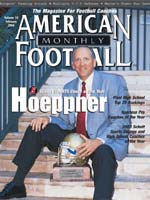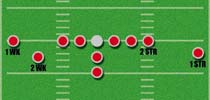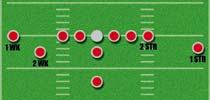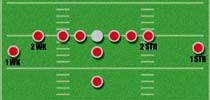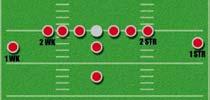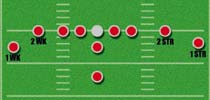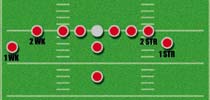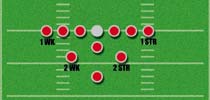Rutgers Passing Attack
Building the pass game through concepts
Asst Head Coach/Wide Receiver Coach, Rutgers University©
More from this issue
In the past 17 years I’ve had the privilege
of being around some very profound football coaches. Some of these
coaches have taught me the many different ways of implementing
the passing game. Thank you for allowing me to share the easiest,
yet most adaptable schemes for any offense. This conceptual system
allows you to:
•
Utilize multiple formations
•
Utilize multiple personnel
•
Visualize pictures when the route concept is called
•
Give you more route options and
combinations with fewer routes
•
Reduce the amount of language in play calling
Because pictures are formulated when the routes are called you and your players
will find it easy learning once the concepts are learned.
Step 1: Implementing the system
Start with any 2-by-2 formation. On the strong side of your formation label the
widest guy 1 strong and the second widest guy 2 strong. Across the ball on the
weakside, label the widest guy 1 weak and the second widest guy 2 weak. If you
have formations that don’t utilize 2-by-2 formation detached (i.e. wishbone),
count the attached receivers as 1 strong/1 weak and call the two back opposite
the FB 2 strong and 2 weak.
Here are six examples of formations. Assume the formations all have right strength
calls. Create the formations you want to use in your offense with your different
personnel groupings. (Diagrams 2-7)
Step 2: Creating your grid
The next phase of building route concepts is creating your route
grid. Take all of your base routes in your system that you want
to run versus all the different
coverages. Be certain you can attack cover 3, cover 2, quarters coverage and
press man coverages. Name your routes. Make sure the name has some association
to the route (i.e. Carolina equals Curls, Georgia equals Go’s, etc.). For
easy learning, take all of your mirrored routes and group them together first.
Then take your routes that are similar (i.e. dig from the boundary and a post
from the field, with the post from the boundary and dig from the field), as your
second grouping. Then your last grouping should be routes that may or may not
have any association. Generally these routes take more memorization. In the first
column put the route name.
In the columns that follow put the rules for 1 strong,
2 strong, 1 weak, 2 weak and the back. The following is an example of a route
grid. Once your players memorize the grid, possibilities are endless:
| Route Name |
1 Strong |
2 Strong |
1 Weak |
2 Weak |
Back |
| Carolina |
Curl |
Flat |
Curl |
Flat |
Spot |
| Gator |
Hitch |
Corner |
Hitch |
Corner |
Spot |
| Ohio |
Out |
Option |
Out |
Option |
Spot |
| Georgia |
Go |
Go |
Go |
Go |
Spot |
| Florida |
Post |
Dig |
Comeback |
Under |
Squirrel |
| Canton |
Post |
Drag |
Dig |
Flat |
Flare |
Step 3: Draw your study sheet grid
On one or two pages, no more, draw all of your routes (your players will learn
it quicker if it is presented on fewer pages). This page should include splits
by the receivers, route with route depths, conversions versus soft hard and press
coverages and quarterback reads. Show the strength all to one side.
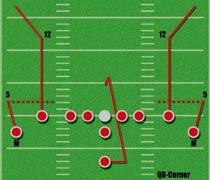 Diagram 8. Gator
Diagram 8. Gator |
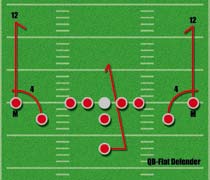 Diagram 9. Carolina
Diagram 9. Carolina |
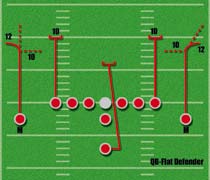 Diagram 10. Ohio
Diagram 10. Ohio |
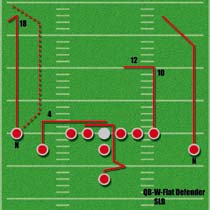
Diagram 11. Florida |
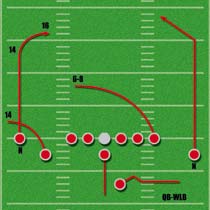 Diagram 12. Canton
Diagram 12. Canton |
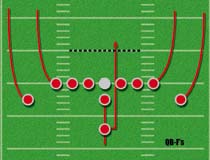 Diagram 13. Georgia
Diagram 13. Georgia |
Step 4: Calling your play
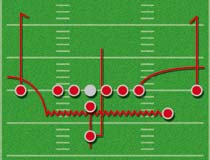 Diagram 14.
Diagram 14.
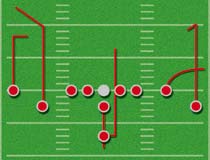
Diagram 15.
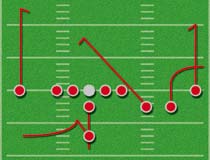
Diagram 16. |
Call your formation first (Jade Trey). Then call your formation
strength next (right). Then call your possible motion (H Left).
Note: The motion man
must know where to end up (1 or 2, weak or strong) within the concept. This
is
done by you in game planning. Protection comes next (rip). Then your route
concept (Carolina). Then your snap count (on 2). Here’s how it sounds: JADE
TREY RIGHT H LEFT RIP CAROLINA ON 2.
Step 5: Combining route concepts and tagging routes
Once you have learned the basic concepts you will have endless possibilities.
This part of building routes is why you don’t need too many routes
in your package. This will multiply your package by 20 if you only have five
total
routes. This section also gives you the flexibility to attack teams that
play different coverages. For example, if a team is playing cover 2 and cover
3
against you throughout the course of a game, you build your route so you
have cover 2 beater side and a cover 3 beater side. When you are combining
your
concepts call the strongside first then the weak. An example of this is: JADE RIGHT CAROLINA GATOR. The strong side runs Carolina and the weakside
runs Gator.
Any three-receiver side should be tagged. Because 3 strong assumes 2 weak’s
responsibilities in a trips set, sometimes there may or may not be a spacing
problem. If you have a route where spacing is poor, you can tag 2 or 3 and
that will eliminate the problem. Do this by calling the total route concept,
and then tagging the letter you want to run a specialized route. Example: JADE
TREY RIGHT LIZ CAROLINA Y SPOT. Be sure you adjust the backs’ routes
as needed.
Special Tags
You can create even greater flexibility with these three tags. Trade Switch
and Swap. When you call trade it exchanges 1 strong and 2 strong’s responsibilities.
When you call switch it exchanges 1 weak and 2 weak’s responsibilities.
When you call swap it will exchange 2 strong and 3 strong’s responsibilities.
You must be in some type of trips set with the swap call. Example: JADE TREY
RIGHT LIZ GEORGIA SWAP
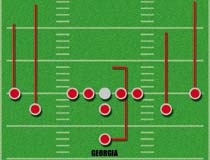 Diagram 17.
Diagram 17. |
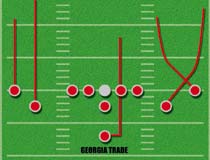 Diagram 18.
Diagram 18. |
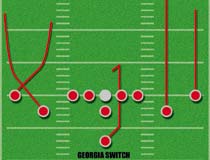
Diagram 19. |
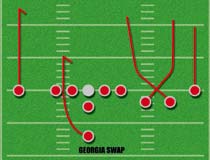 Diagram 20.
Diagram 20. |
I hope the thoughts we have shared benefit you and your football
program. On behalf of head coach Greg Schiano and our staff,
thank you for the opportunity
and good luck next season.
If you liked this article, here are three others just like
it:
|
About the author
Darrell Hazell
Darrell Hazell is in his third season as wide receivers coach and first
year assuming the role of Assistant Head Coach, where he will aid Head
Coach Greg Schiano with a number of administrative duties.
A native of Cinnaminson, NJ, Hazell brings an extensive resume to the Scarlet
Knights. Prior to joining the West Virginia staff in 1999, Hazell coached tight
ends and split ends at the United States Military Academy for two seasons (1997-98).
Hazell served as running backs coach from 1999-2000 at West Virginia. Under his
direction, Mountaineer running back Avon Cobourne developed into one of the top
rushers in the country.
For more information, email: dhazell@scarletknights.com
